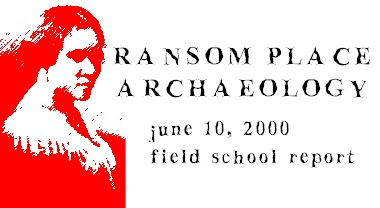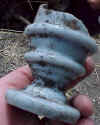 |
| We've nearly completed the summer and recovered a substantial assemblage of domestic refuse from the last century. While we know the lot was a corner store for this period, the refuse actually appears to be typical of domestic discards: that is, we have not identified unusual percentages of particular artifact types. By week's end we will begin to wrap up the season's excavations and begin the task of analyzing the thousands of objects that have come out of the field school excavations. |  |
![]()
![]()
![]()
 This
light blue glass table vessel was once quite stylish and still bears
the traces of a gilded decoration. This
light blue glass table vessel was once quite stylish and still bears
the traces of a gilded decoration. |
These artifacts were all found
in a deposit that appears to date to the early twentieth century.
They include a crushed thimble (bottom left), the finish (i.e., rim) of a stoneware bottle (top left), a
stoneware smoking pipe (center), and two fragments of stoneware pipes
(right).
(bottom left), the finish (i.e., rim) of a stoneware bottle (top left), a
stoneware smoking pipe (center), and two fragments of stoneware pipes
(right). |
Heather Childress' trowel is the
blur retrieving this broken bottle from the structure's fill. |
This  utensil
handle was cleverly bent into a ring to serve as makeshift jewelry. utensil
handle was cleverly bent into a ring to serve as makeshift jewelry. |
|
|
| The object above is a pliable metal disc roughly 1.5" in diameter impressed with a patriotic motif. It was recovered from deposits that are tentatively dated to about 1910. Let us know if you think you know what it is. Email at paulmull@iupui.edu | ||
|
|
A shake of
this sealed metal
When the tin was opened in the lab, it
turned out |
 Email
us at paulmull@iupui.edu Email
us at paulmull@iupui.edu
|